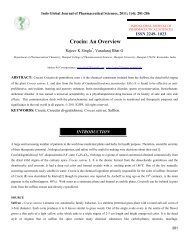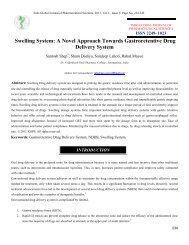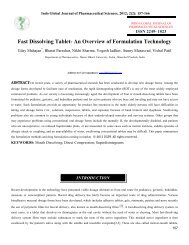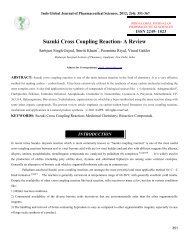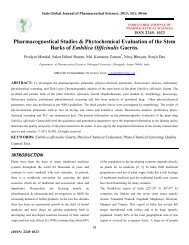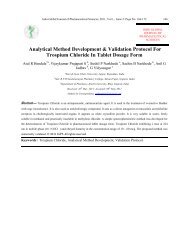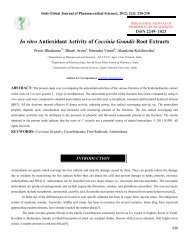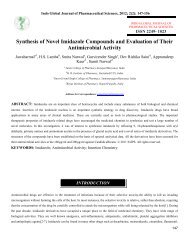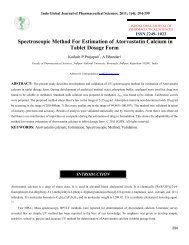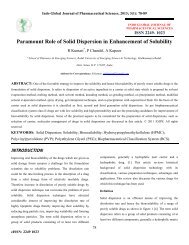Formulation, Development & Characterization of Ofloxacin ...
Formulation, Development & Characterization of Ofloxacin ...
Formulation, Development & Characterization of Ofloxacin ...
You also want an ePaper? Increase the reach of your titles
YUMPU automatically turns print PDFs into web optimized ePapers that Google loves.
Indo Global Journal <strong>of</strong> Pharmaceutical Sciences, 2012; 2(2): 130-141Korsmeyer–Peppas model describe the mechanism <strong>of</strong> drug release [18].The following plots were made: cumulative % drug release vs. time (zero order kinetic model); log cumulative <strong>of</strong> % drug remainingvs. time (first order kinetic model); cumulative % drug release vs. square root <strong>of</strong> time (higuchi model) log cumulative % drug releasevs. log time (korsmeyer-peppas model) and cube root <strong>of</strong> drug % remaining in matrix vs. time (hixson-crowell cube root law).S. NoPhysical stabilityStorageDrug contentTime (Days)(Visualcondition(%)observation)1 RT Initial 94.32 NOC2 RT 7 th day 94.16 NOC3 RT 14 th day 93.90 NOC4 RT 21 st day 93.47 NOC5 RT 28 th day 93.28 NOCTable 5. Stability studies <strong>of</strong> <strong>Ofloxacin</strong> Microspheres[NOC – No observable changes; RT – Room temperature (25 0 C ± 2 0 C)]Stability studiesThe finalized formulation (F5) <strong>of</strong> microspheres were taken in a crucible and stored at room temperature (25 0 C ± 2 0 C) for 28 days .Thereadings were taken at 7 days at periodical intervals (0 th , 7 th , 14 th , 21th, and 28 th day). The microspheres were analyzedspectophotometrically at 294 nm after proper dilutions to evaluate the drug content. The physical stability was also observedperiodically [3].RESULTS & DISCUSSIONIn this study, attempts have been made to develop and formulate chitosan-coated microspheres by non-ionic cross linking technique.The concentration <strong>of</strong> calcium chloride was retained in all batches. This was to prevent instant gelling <strong>of</strong> sodium alginate on addition <strong>of</strong>calcium chloride and squeezing out <strong>of</strong> the aqueous phase from gel lattice. The influence <strong>of</strong> alginate concentration was evaluated withthree different concentrations (1.0; 2; 2.5; 3.0%).The SEM micrographs and typical surface morphology <strong>of</strong> the microspheres were shown in Figure 4A and Figure 4B. Themicrospheres prepared were spherical with smooth surface. The smooth surface was due to the use <strong>of</strong> optimum concentration ratio <strong>of</strong>calcium chloride as 1% in all batches. As expected, decreasing the alginate concentration decreased the microsphere size. Therefore,an alginate concentration <strong>of</strong> 3% was used in the further preparations.The average particle size <strong>of</strong> microspheres was between 7 to 14 µm which was carried out by using optical microscope fitted with eyepiece micrometer which was then calibrated with stage micrometer.The average size <strong>of</strong> microsphere particles increased withincreasing polymer (chitosan).135




